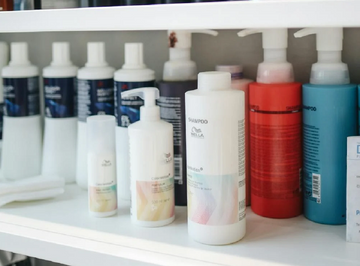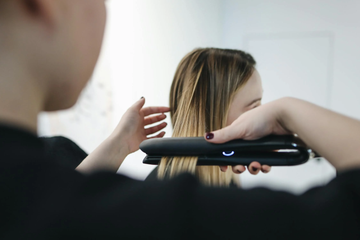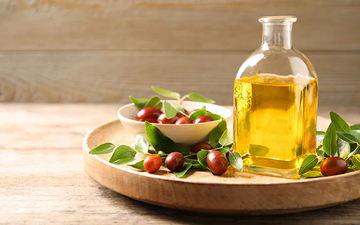Discover the truth about what’s lurking in your haircare
Ever wonder if your haircare is secretly sabotaging your strands? It’s not just about what your shampoo promises; it’s about the hidden culprits lurking in the fine print.
Harmful ingredients in hair products like harsh chemicals and sneaky additives can leave your hair crying for help. Keep reading, as we’re exposing the worst offenders and uncovering what your locks really need to thrive.
11 ingredients to avoid in hair products
❌ Sulphates, the lather you don’t need!
Sulfates, like Sodium Lauryl Sulfate (SLS) and Sodium Laureth Sulfate (SLES), are industrial-strength detergents that create the bubbly lather we’ve all been conditioned to expect from a “good” shampoo.
Where they’re found: Shampoos, body washes, toothpaste—basically anything that’s meant to foam.
Why they should be avoided: Sure, sulfates deliver a satisfying sudsy cleanse, but they also strip your hair of its natural oils and moisture barrier. That squeaky-clean feeling? It’s your hair begging for hydration. Over time, sulfates can leave hair dull, brittle, and prone to breakage while exacerbating issues like frizz, scalp irritation, and dryness. If your hair is color-treated, sulfates are the fast lane to faded hues and salon touch-ups.
Alternatives: Gentle, sulfate-free cleansers are the way forward. Look for products featuring coconut-based surfactants like cocamidopropyl betaine or decyl glucoside, which clean your hair without leaving it thirsty. These products are a godsend for curls, colored hair, or dry strands.
❌ Silicones, the quick fix that sticks around
Silicones, such as Dimethicone and Cyclopentasiloxane, are synthetic polymers designed to coat your hair, giving it that silky-smooth, frizz-free look.
Where they’re found: You’ll see these in conditioners, serums, heat protectants, and styling creams—basically anything promising instant sleekness.
Why they should be avoided: Silicones might make your hair feel like spun silk initially, but they’re the ultimate illusionist. They create a superficial shine while sealing out essential moisture and nutrients. Over time, non-water-soluble silicones can build up, making hair greasy, heavy, and lifeless. Worse, removing them often requires harsh shampoos (think sulfates), creating a vicious cycle of damage.
Alternatives: Ditch the fake gloss and opt for lightweight natural oils like argan, jojoba, or sweet almond oil to hydrate and add shine without the buildup. Pair this with silicone-free conditioners and leave-ins to maintain that fresh, bouncy look. Your hair will look (and feel) genuinely healthy, not just smooth on the surface.
❌ Parabens, the preservative with a reputation problem
Parabens, like Methylparaben and Propylparaben, are synthetic preservatives that prevent bacteria and mold from growing in your hair products.
Where they’re found: Shampoos, conditioners, styling gels, and any product with water in its formula.
Why it should be avoided: Parabens may keep your products fresh, but they’ve sparked serious debates about their long-term effects. These compounds can mimic estrogen in the body, potentially disrupting hormones. They’re also linked to skin irritation and sensitivities, particularly for those with eczema or allergies. While the research is ongoing, parabens are often avoided as a "better safe than sorry" measure.
Alternatives: Look for haircare products preserved with phenoxyethanol, potassium sorbate, or natural extracts like rosemary or grapefruit seed. These alternatives keep your products safe without the potential hormone concerns.
❌ Formaldehyde-releasing agents, a slow-release nightmare
Ingredients like DMDM Hydantoin and Quaternium-15 are preservatives that slowly release formaldehyde to combat bacteria and extend shelf life.
Where they’re found: Shampoos, conditioners, keratin treatments, and some leave-in products.
Why they should be avoided: Formaldehyde is a known carcinogen, and these slow-release agents have been associated with allergic reactions, scalp irritation, and respiratory issues. If you’ve ever had a keratin treatment and noticed itchy eyes or a burning scalp, formaldehyde might be the culprit. Even in smaller doses, these agents can be a risk over time, especially with frequent use.
Alternatives: Prioritize products labeled “formaldehyde-free” or those with clean preservatives like sodium benzoate or benzyl alcohol. Better yet, explore brands dedicated to transparency about their ingredients.
❌ Phthalates, the hidden villain in fragrance
Phthalates like DEP (Diethyl Phthalate) and DBP (Dibutyl Phthalate) are chemicals added to enhance fragrance longevity or improve the flexibility of hair product formulas.
Where they’re found: Hair sprays, gels, mousses, and heavily fragranced shampoos and conditioners.
Why they should be avoided: Phthalates are potential endocrine disruptors, meaning they can interfere with hormone systems. Studies have also linked them to reproductive health concerns, especially in pregnant individuals. On a less extreme but still annoying level, phthalates can irritate sensitive scalps and skin.
Alternatives: Opt for fragrance-free haircare or products scented naturally with essential oils like lavender, peppermint, or citrus. For styling products, look for those explicitly labeled “phthalate-free” to steer clear of these sneaky chemicals.
❌ Artificial fragrances and colors, the sneaky culprits
Artificial fragrances and colors are lab-made additives designed to make your products smell and look more appealing.
Where they’re found: Pretty much everywhere—shampoos, serums, conditioners, and anything with a strong scent or vibrant hue.
Why they should be avoided: These synthetic ingredients are often hidden behind the vague label of "fragrance" or "color," which can mask a cocktail of potentially harmful chemicals. They’re notorious for causing scalp irritation, allergic reactions, and even headaches or respiratory issues. Some artificial dyes are also linked to toxic effects when absorbed over time.
Alternatives: Stick to “fragrance-free” products or those scented with natural essential oils like lavender or rosemary. When it comes to color, trust products that rely on plant-based ingredients, like beetroot powder or turmeric, for a touch of visual appeal.
❌ Alcohols, the good, the bad, and the brittle
Not all alcohols are bad, but drying alcohols like Isopropyl Alcohol and SD Alcohol are common solvents used to create lightweight textures and quick-drying effects
Where they’re found: Hairsprays, gels, volumizers, and some leave-in products.
Why they should be avoided: These alcohols are moisture thieves, evaporating quickly and leaving your hair parched, brittle, and prone to breakage. If your curls are suddenly frizz central or your straight strands feel like straw, drying alcohols might be to blame.
Alternatives: Seek out products with hydrating fatty alcohols, like cetyl, stearyl, or behenyl alcohol, which smooth the hair cuticle and add moisture. For styling, water-based formulas are often gentler on your strands.
❌ Polyethylene glycol (PEGs), the chemical thickener
PEGs are petroleum-derived compounds used as thickeners, softeners, and emulsifiers to keep product ingredients mixed.
Where they’re found: Shampoos, conditioners, styling creams, and leave-ins.
Why they should be avoided: While PEGs can give products a creamy, luxurious feel, they can also strip your hair of natural oils, leaving it dry and lackluster. Even worse, PEGs may be contaminated with harmful by-products like ethylene oxide and 1,4-dioxane—both of which are potentially carcinogenic.
Alternatives: Look for products that use natural emulsifiers like aloe vera, xanthan gum, or guar gum. These ingredients work to thicken and stabilize formulas without the harsh side effects, keeping your hair soft and healthy.
❌ Mineral oil and petrolatum, the moisture impostors
Mineral oil and petrolatum are petroleum byproducts often marketed as moisture-locking heroes, but they’re more like double agents.
Where they’re found: You’ll spot them in hair oils, pomades, and scalp treatments promising shiny, hydrated hair.
Why they should be avoided: These heavyweights coat your hair, creating a barrier that locks out more than moisture—it blocks essential nutrients too. Over time, they suffocate your strands, leaving them dull and lifeless. Plus, they’re notoriously hard to wash out, meaning you’re in for a whole lot of build-up if you’re not careful.
Alternatives: Swap them for lightweight, nutrient-rich oils like almond, grapeseed, or argan oil, which hydrate without suffocating your hair. Shea butter-based products also deliver moisture with a softer touch.
❌ Triclosan, the chemical you don’t need
Triclosan is an antimicrobial agent once hyped for its bacteria-busting abilities.
Where they’re found: Occasionally lurking in shampoos and anti-dandruff treatments.
Why they should be avoided: While triclosan might zap germs, it’s also linked to hormone disruption and environmental harm—like polluting waterways and affecting aquatic life. On top of that, overuse can lead to resistant bacteria (yikes!).
Alternatives: Let Mother Nature handle it with natural antibacterial ingredients like tea tree oil, neem, or rosemary extract. They keep your scalp healthy without compromising your body or the planet.
❌ DEA, MEA, and TEA (Ethanolamines), the foaming fakers
Ethanolamines like DEA (Diethanolamine), MEA (Monoethanolamine), and TEA (Triethanolamine) are chemical agents used to create foam and stabilize products.
Where they’re found: You’ll find these in shampoos, conditioners, and styling products with frothy textures.
Why they should be avoided: While they give you a luxurious lather, ethanolamines have a dark side. They can interact with other ingredients to form nitrosamines—potential carcinogens—and they’re infamous for causing skin irritation and dryness.
Alternatives: Choose products labeled “ethanolamine-free” and opt for plant-based foaming agents like coco-glucoside or decyl glucoside. They’ll cleanse without compromising your hair—or your health.
What ingredients to look for in haircare
If avoiding harmful ingredients is step one, step two is knowing what to embrace. The right haircare ingredients nourish your strands, support your scalp, and help you achieve your dream hair goals—without compromising your health. Here’s a breakdown of powerhouse ingredients to look for:
✅ Coconut-based surfactants are gentle cleansers
If you’ve been chasing sulfate-free shampoos, chances are you’ve come across coconut-based surfactants like cocamidopropyl betaine. These gentle cleansers are ideal for anyone tired of the harsh effects of traditional detergents. They clean your hair without stripping it of its natural oils, leaving it hydrated and happy—Hallelujah!
Why they’re great: Unlike sulfates, which can be harsh and drying, coconut-based surfactants are mild yet effective. They cleanse your scalp and hair without disrupting its natural moisture barrier, making them perfect for sensitive scalps, dry hair, or curls prone to frizz. Bonus: they’re derived from renewable resources, so they’re kinder to the planet too.
Where you’ll find them: Look for coconut-based surfactants in sulfate-free shampoos, gentle cleansing conditioners, and micellar hair cleansing waters. They’re especially common in products designed for dry, damaged, or color-treated hair.
✅ Aloe vera is nature’s moisturizer
Aloe vera isn’t just for soothing sunburns—it’s a superstar for your hair too. Packed with vitamins, enzymes, and amino acids, aloe vera hydrates your strands while keeping your scalp happy and balanced.
Why it’s great: Aloe vera is a natural humectant, meaning it draws moisture into the hair, making it softer, shinier, and less prone to breakage. It’s also soothing for irritated scalps, thanks to its anti-inflammatory properties, and can help combat dandruff without harsh chemicals.
Where you’ll find it: You’ll spot aloe vera in hydrating shampoos, leave-in conditioners, and scalp treatments. It’s especially common in products for dry, brittle, or damaged hair, as well as those aimed at promoting growth.
✅ Argan oil is liquid gold for hair
Argan oil has earned its nickname “liquid gold” for a reason. This nutrient-dense oil from Moroccan argan trees is a savior for dry, frizzy, or damaged hair.
Why it’s great: Rich in antioxidants, essential fatty acids, and vitamin E, argan oil nourishes and strengthens hair while adding an incredible shine. It tames flyaways, smooths frizz, and even provides heat protection. Plus, it’s lightweight, so it won’t leave your hair feeling greasy or weighed down.
Where you’ll find it: You’ll find argan oil in everything from smoothing serums and leave-ins to deep conditioning masks and curl creams. It’s a must-have in any anti-frizz or shine-enhancing product.
✅ Shea butter is the big softie
Shea butter is a deeply nourishing ingredient derived from the nuts of the African shea tree. Known for its rich texture and high-fat content, it’s a dream for thirsty curls and damaged ends.
Why it’s great: Shea butter is a natural emollient that locks in moisture, making hair softer and more manageable. Its fatty acids coat each strand to protect against environmental damage, while its vitamins (A and E) promote healthier growth. It’s particularly beneficial for curly, coily, or chemically treated hair.
Where you’ll find it: You’ll see shea butter in curl-defining creams, deep conditioning masks, and moisturizing hair balms. It’s especially beloved in leave-in products and styling creams for textured hair types.
✅ Jojoba oil is balanced nourishment
Jojoba oil is often called the closest thing to your scalp’s natural oils, making it an ideal ingredient for balancing hydration without overloading your hair.
Why it’s great: Lightweight and non-greasy, jojoba oil moisturizes hair strands and scalp alike. Its molecular structure is similar to sebum, so it nourishes without clogging pores. It’s also packed with vitamins and minerals like vitamin C, B vitamins, and zinc, which help strengthen hair and prevent breakage.
Where you’ll find it: Jojoba oil is a common ingredient in scalp treatments, lightweight serums, and frizz-taming sprays. It’s especially useful in products for fine or oily hair types that still need a touch of hydration.
✅ Panthenol is a strength and shine booster
A derivative of vitamin B5, panthenol is a powerhouse ingredient that both strengthens and adds shine to your hair. It’s a go-to for those looking to improve the overall texture of their locks.
Why it’s great: Panthenol works by penetrating the hair shaft and locking in moisture, making hair softer, shinier, and less prone to split ends. It also forms a thin protective layer around each strand, adding volume and reducing frizz without weighing your hair down.
Where you’ll find it: Panthenol pops up in volumizing shampoos, leave-in conditioners, and hair repair serums. It’s great for all hair types, but especially beneficial for fine or damaged hair in need of strength and shine.
✅ Rice water extract is an ancient growth secret
Rice water extract has been a beauty staple for centuries in East Asia, celebrated for its ability to fortify and grow long, healthy hair.
Why it’s great: Packed with amino acids, vitamins, and inositol, rice water strengthens hair from root to tip while improving elasticity and reducing friction. It’s known for repairing damaged strands and boosting shine. Regular use can also help stimulate hair growth and prevent thinning.
Where you’ll find it: Look for rice water extract in growth-promoting shampoos, hair masks, and treatments aimed at reducing breakage. It’s especially popular in products targeting thinning hair or brittle ends.
Always check the bottle
Choosing the right ingredients is about more than avoiding the bad—it’s about prioritizing the good. Look for products that combine hydrating, strengthening, and protective elements for hair that’s not just clean, but genuinely healthy. It’s time to make your haircare shelf as intentional as your skincare routine.





